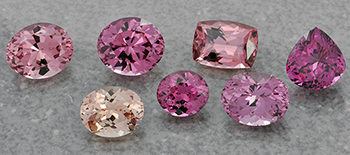In the recent multi-shipment seizure, CBP also found counterfeit Audemars Piguet, Moncler, and Chrome Hearts items.
5 Predictions for the Tucson Gem Shows
National Jeweler spoke with gem dealers and exhibitors about their expectations for the upcoming shows. Here’s what they had to say.

New York--It seems to come upon us so quickly.
The holidays come and go in the blink of an eye, the industry takes over New York in early January with a slew of events and then, not long after, head west to take part in the gem shows in Tucson.
Soon that migration will be happening again, as events--the American Gem Trade Association’s GemFair, the Gem and Jewelry Exchange, JCK Tucson and a host of others--happen across the Arizona city.
National Jeweler spoke with a number of gem dealers and exhibitors about their expectations for Tucson 2017. Here’s what they had to say.
1. Prices could ease.
The slowdown in spending in Asian markets, especially in China, is not a new development. Yet it continues to effect the gemstone market as buying is down and gemstone companies have had to turn their focus elsewhere.
With the Chinese market still relatively subdued and the focus shifting to other markets, especially the United States, prices may level off especially in the areas where Asian buyers purchased in large numbers, Cara Williams of Bear Williams said.
The stock market’s recent rise also means that people have become more comfortable spending on luxury goods of late, and a number of gemstone dealers indicated they think business in Tucson could be steady.
2. Pastels will continue to reign.
Show after show, these light-hued gems continue to lead the way, and this year’s Tucson shows won’t be the exception.
Williams said, “Some colors and cuts are in high demand and very limited supply, so I expect smart buyers to be looking to buy these when they find them. Peach stones, especially, fall into this category. Some fall within the range for padparadscha while others fall outside this narrowly defined colored range, and it makes a significant difference in price.”
This trend will help light-colored sapphires, carry forward the popularity of morganite (especially in the pink hues) and also includes the fancy colored garnets that are coming out of East Africa and being marketed as “Malaya,” according to Mayer & Watt’s Simon Watt, which provides a lot of beautiful pinks and oranges.
“Many retailers are starting to catch onto this newer wave of market demand and stocking at least a few pieces that they can show to this profitable market segment,” gemstone cutter John Dyer said.
3. And so will sapphires.
Sapphires have been the stars of many a trade show for years now, being exhibited and sold by many attendees at last year’s Tucson shows and during the Las Vegas market week as well.
The classic blue remains a top gemstone to leverage for the colored bridal trend mentioned above, but people are loving more and more the fancy colored options the stone offers.
Jeremy Hakimi of Colorline Inc. said they are seeing a lot of demand for “bread-and-butter” goods such as sapphires in the 1- to 5-carat range, especially fine quality merchandise that is well cut and eye clean.
Paul Dragone of Boston Gems said sapphire has been one of his company’s two bestsellers throughout the past year (the other being moonstone) and said customers have asked for the stone in all colors, including padparadscha and those from Montana, and he expects that to carry through Tucson as well.
Sapphires originating from a new source in Madagascar discovered last fall are showing up in the market with decent cuts, according to Watt, which should help with the lack of production from Sri Lanka.
“Hopefully, this might take (away) some of the upward pressure on prices for blue sapphire that the market has been experiencing over the past five years,” Watt said, adding that the weakening of the Chinese market also should help lower prices.
Other gems dealers said are getting a lot of love are tourmaline, spinel and garnets of all colors.
4. Burmese rubies might not be prevalent yet.
Though the ban was lifted in October, there might not be an influx of rubies into the U.S. market for the Tucson gem shows.
“Even though the ban has been lifted, prices remain very strong as there is currently very little mining and production,” Colorline’s Hakimi said.
He added that he does think there will be a lot of Mozambique rubies in Tucson, however, which can rival the qualities of fine Burmese material and in many cases, offer a better price point.
Watt, too, said he doesn’t think the amount of Burmese rubies on the market will be significantly different in Tucson though there will be, of course, a few big Burmese companies in Tucson and it’s likely that big retailers and manufacturers will be actively buying for the first time in years.
When news that the ban was being lifted was announced in the fall, American Gem Trade Association President and CEO Doug Hucker said much of the same, telling National Jeweler at the tim that he didn’t think there would be sudden influx of Burmese rubies into the U.S. market.
“This is a very strong relationship business,” he said, noting that many people who moved on from Burmese rubies once the ban was enacted likely would have to take some time to re-establish their relationships at the source.
Tucson could be the perfect opportunity to do that, though, and it remains to be seen how much business surrounding the stone will be had.
5. There will be a focus on cut and quality.
After all, buyers are coming to Tucson to find “special and inspirational items” that evoke an emotional response, as gemstone dealer James Alger says.
Dyer reiterated the thought, saying that, “More important than the exact color or material quality is what stands out.”
He added that recently the market has been showing a preference for a slightly smaller gem if it is of better quality.
Along the same lines, “special” or unique gems continue to sell faster than larger and less expensive (per carat) gems that don’t stand out.
In addition to shapes, the cutting quality has become even more of a factor to buyers, Dyer said, with more people educating themselves about the difference that a good cut can make, and looking for those that best show off the gem.
For Bear Essentials, Williams said the cushion cuts have continued to be in demand while ovals and especially trillions have slowed down. Requests have picked up for pear and marquise cuts.
The company also is seeing an increased demand for untreated stones, noting that consumers increasingly do their own research on the internet to know what they want.
“This is also an area we have long focused on, as we appreciate the rarity of all natural gems and have a lab that is equipped to test for all treatments,” she said. “I don’t recommend unheated gems for most calls, but they have appreciated more than comparable heated stones and promise to continue with strong demand from the more discerning end of the market.”
The Latest

Helzberg’s Chief Retail Officer Mitch Maggart shared details about its tests of a new store concept rooted in an elevated luxury experience.

Jewelers of America execs and National Jeweler editors discuss tariffs, the sky-high gold price, and the engagement that broke the internet.

How Jewelers of America’s 20 Under 40 are leading to ensure a brighter future for the jewelry industry.

The luxury goods company said founder Ippolita Rostagno will remain at the brand’s helm.


Laura Burdese, who joined the Italian luxury brand in 2022, will take on the role in July.

The National Jeweler editors revisit the most noteworthy industry happenings and design trends from 2025.

Roseco’s 704-page catalog showcases new lab-grown diamonds, findings, tools & more—available in print or interactive digital editions.

Need a gift for the cat lover who has everything? Look no further than our latest Piece of the Week.

It purchased the “Grosse Pièce,” an ultra-complicated Audemars Piguet pocket watch from the ‘20s, for a record-breaking price at Sotheby’s.

The lab-grown diamond grower now offers custom engagement and fashion jewelry through its Kira Custom Lab Jewelry service.

Chandler got his start at Michelson Jewelers and has served as DCA president and CEO since 2001. He will retire at the end of the month.

The boutique is slated to open this week inside Terminal 8, offering pre-owned Rolex watches and more to international travelers.

Sponsored by Digital Monitoring Products

The special-edition egg pendant ingested in a New Zealand jewelry store was recovered after a six-day wait.

Associate Editor Natalie Francisco plays favorites with Piece of the Week, selecting a standout piece of jewelry from each month of 2025.

The “Love and Desire” campaign is inspired by the magic that follows when one’s heart leads the way, said the brand.

Two awardees will receive free tuition for an educational course at the Swiss lab, with flights and lodging included.

Berta de Pablos-Barbier will replace Alexander Lacik at the start of January, two months earlier than expected.

Sotheby’s held its first two jewelry sales at the Breuer building last week, and they totaled nearly $44 million.

Here are six ideas for making more engaging content for Instagram Reels and TikTok, courtesy of Duvall O’Steen and Jen Cullen Williams.

Carlos Jose Hernandez and Joshua Zuazo were sentenced to life without the possibility of parole in the 2024 murder of Hussein “Sam” Murray.

Yood will serve alongside Eduard Stefanescu, the sustainability manager for C.Hafner, a precious metals refiner in Germany.

The New Orleans jeweler is also hosting pop-up jewelry boutiques in New York City and Dallas.

Set in a Tiffany & Co. necklace, it sold for $4.2 million, the highest price and price per carat paid for a Paraíba tourmaline at auction.

The jeweler’s “Deep Freeze” display showcases its iconic jewelry designs frozen in a vintage icebox.

Take luxury gifting to new heights this holiday season with the jeweler’s showstopping 12-carat sphene ring.



























